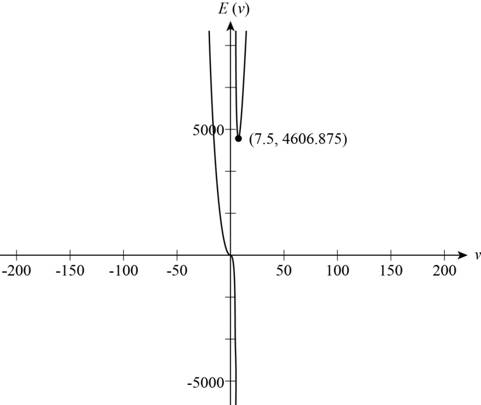
Concept explainers
Migrating Fish A fish swims at a speed v relative to the water, against a current of 5 mi/h. Using a mathematical model of energy expenditure, it can be shown that the total energy E required to swim a distance of 10 mi is given by
Biologists believe that migrating fish try to minimize the total energy required to swim a fixed distance. Find the value of v that minimizes energy required.
[Note: This result has been verified; migrating fish swim against a current at a speed 50% greater than the speed of the current.]
The value of v which minimizes the total energy required to swim a fixed distance.
Answer to Problem 52E
The value of v which minimizes the total energy is 7.5mi/h.
Explanation of Solution
Given:
The total energy required to swim a distance of 10 mi against a current of 5 mi/h is given by,
Calculation:
Use a graphing calculator to draw the graph of the function E with respect to v as shown in Figure 1.

Figure (1)
Locate the point at which local minimum occurs to find the value of v which minimizes the total energy.
The value
From Figure (1), it is noticed that there is one local minimum between
Point
The value 4606.875 is minimum for
Therefore, the value of v which minimizes the total energy is 7.5mi/h.
Chapter 2 Solutions
Precalculus: Mathematics for Calculus - 6th Edition
Additional Math Textbook Solutions
Mathematics for the Trades: A Guided Approach (11th Edition) (What's New in Trade Math)
Precalculus: A Unit Circle Approach (3rd Edition)
Elementary Algebra For College Students (10th Edition)
Calculus: Early Transcendentals (2nd Edition)
Intro Stats, Books a la Carte Edition (5th Edition)
Elementary and Intermediate Algebra: Concepts and Applications (7th Edition)
- 16. Solve each of the following equations for x. (a) 42x+1 = 64 (b) 27-3815 (c) 92. 27² = 3-1 (d) log x + log(x - 21) = 2 (e) 3 = 14 (f) 2x+1 = 51-2xarrow_forward11. Find the composition fog and gof for the following functions. 2 (a) f(x) = 2x+5, g(x) = x² 2 (b) f(x) = x²+x, g(x) = √√x 1 (c) f(x) = -1/2) 9 9(x) = х = - Xarrow_forwardpractice problem please help!arrow_forward
- 13. A restaurant will serve a banquet at a cost of $20 per person for the first 50 people and $15 for person for each additional person. (a) Find a function C giving the cost of the banquet depending on the number of people p attending. (b) How many people can attend the banquet for $2000?arrow_forwardAlt Fn Ctrl 12. Find functions f and g such that h(x) = (fog)(x). (a) h(x) = (x² + 2)² x+1 (b) h(x) = 5 3arrow_forward15. Find the exact value. (a) log4 16 (b) log7 1 49 (c) logs 3/25arrow_forward
 Calculus: Early TranscendentalsCalculusISBN:9781285741550Author:James StewartPublisher:Cengage Learning
Calculus: Early TranscendentalsCalculusISBN:9781285741550Author:James StewartPublisher:Cengage Learning Thomas' Calculus (14th Edition)CalculusISBN:9780134438986Author:Joel R. Hass, Christopher E. Heil, Maurice D. WeirPublisher:PEARSON
Thomas' Calculus (14th Edition)CalculusISBN:9780134438986Author:Joel R. Hass, Christopher E. Heil, Maurice D. WeirPublisher:PEARSON Calculus: Early Transcendentals (3rd Edition)CalculusISBN:9780134763644Author:William L. Briggs, Lyle Cochran, Bernard Gillett, Eric SchulzPublisher:PEARSON
Calculus: Early Transcendentals (3rd Edition)CalculusISBN:9780134763644Author:William L. Briggs, Lyle Cochran, Bernard Gillett, Eric SchulzPublisher:PEARSON Calculus: Early TranscendentalsCalculusISBN:9781319050740Author:Jon Rogawski, Colin Adams, Robert FranzosaPublisher:W. H. Freeman
Calculus: Early TranscendentalsCalculusISBN:9781319050740Author:Jon Rogawski, Colin Adams, Robert FranzosaPublisher:W. H. Freeman
 Calculus: Early Transcendental FunctionsCalculusISBN:9781337552516Author:Ron Larson, Bruce H. EdwardsPublisher:Cengage Learning
Calculus: Early Transcendental FunctionsCalculusISBN:9781337552516Author:Ron Larson, Bruce H. EdwardsPublisher:Cengage Learning





